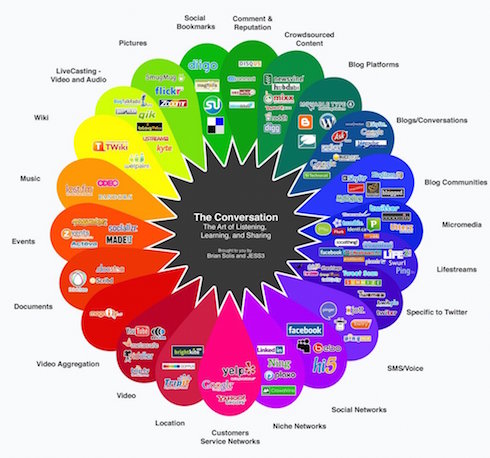By adaptive - December 17th, 2014
Finding the right niche networks for your corporation needs careful planning and foresight
Over the past two weeks we’ve been exploring the niche social network and its impact on social media interaction and brand engagement.
These diverse and well-populated networks afford your corporation a remarkable new landscape in which it can build a richer brand presence and potentially target your social marketing far more effectively. In this final part we will be asking the experts how to identify the right networks for your brand and look at some examples of how organisations have used niche social to achieve impressive results.
According to Gavin Hammar, founder and CEO of Sendible the first step towards identifying the niche social networks that are right for your business is to find those that have a membership that would instantly be an advocate of your brand or product.
“If you provide cycling equipment, become part of a social network that appeals to cyclists. The key to being successful is to make sure that members of these social networks are likely to recommend your product,” he adds. “It does largely depend, however, on factors such as industry, product and location. Keep in mind the objectives and aims of your strategy and decide if you want convert prospects or retain customers.”
According to the Digital Trends Report by 33 Digital and Hotwire, users are becoming increasingly sophisticated and less interested in the random noise of Facebook and Twitter. Organisations that strategically engage with consumers on niche networks need to ensure that their messaging and communications are highly focused and targeted, not just bringing a generic noise to a new platform.
It’s the art of listening and holding conversations where social is fine-tuned and focused – a stream of social commentary and engagement versus the roaring waterfall of social noise that the giant networks have become.
In some cases it’s easy. A cycling brand can leap at the opportunity presented by Strava a specialist site for cyclists and runners with an undisclosed number of users, but an impressive data stream of well over 375 data points in the USA alone.
However, what of brands that have a more diverse array of products or solutions? How do they find their way through lists [http://www.geniusstartup.com/social-media-sites-for-marketing/] of niche social networks with active communities and highly specialised topics?
“In the real world it isn’t easy finding where they [the consumers] are, let alone who they are,” says Prakash Patel, Chief Strategy Officer of Fogg Experiential Design. “One size may not fit all as it will depend on your brand, sector; target group and nature. It’s easy to subscribe to all of them and take the attitude of more is better by throwing the net wide to cover all your bases, but the quality of your brand’s social media efforts is much more important than the quality.”
It is a good idea to plan and identify a marketing goal – research, listen, understand and identify where your current and potential customers may be hanging out and then get to know them. It’s also worth examining where competitors are playing, if they are sitting in spaces that you’ve not yet explored, then those could well be new opportunities ideal for your brand to explore.
“I have seen some brilliant social brand hijack engagements online,” adds Patel. “A complaint by one customer about its current supplier is hijacked by an offer from a competitor.”
Finding the niche
Will Green, CEO Apurimac Media suggest four steps towards identifying the right networks for brands:
1. Align audiences – don’t be surprised if a new use or demographic for a product or service is uncovered through the relationship with the network.
2. Align brand values with those of the network – authentic voice and matching values are two of the easiest ways to select the platform best suited for a brand.
3. Be mindful of the medium, and the journey – staying aware of the user’s journey and how the medium is used will ensure the brand remains relevant and that no strategic opportunities are missed.
4. Don’t be afraid to make mistakes – learn from them, get better at the process and be prepared to change.
One brand that took the niche concept to heart was Toyota. This global car company used niche media platforms preferred by environmental groups to promote the Prius, their first mass-produced hybrid car. The result is that Toyota has come to dominate the niche with this specific range of vehicles and is today moving out of the niche and into the mainstream with its 2014 campaigns.
Sony has recently run a very successful social media campaign on WhatsApp – one of the most active niche networks on the go at the moment. With around 450 million monthly users (significantly more than Twitter’s 215 million) it is possibly a matter of debate as to whether WhatsApp still qualifies as a niche, but it does have enormous potential if done right.
Sony DADC India initiated engagement through the usual suspects on Facebook and Twitter. Engagement was very precise with around 90 people eventually entering into one of three active groups of 25-30 members. The participants continued to chat even when Sony wasn’t initiating debate, and the forum gave the organisation an impressive space in which to interact and build the brand with consumers now actively engaged in the company and its conversations.
This level of interaction may not sit in the thousands, but every one of the participants has chosen to become a part of the brand story. It’s this that makes the niche networks such an exciting opportunity for any corporation – engagement is absolutely focused and tight.
“We join communities that discuss topics relevant to our company,” says Hammar. “We share content and advice that could be useful to people in that community without necessarily promoting our product. We also recommend that organisations reward loyal customers and those who refer business through recommendations as this will make it more likely that they continue to do so.”
Create a buzz around your brand and make customers want to talk about your business, as this is a sure-fire way of building a strong presence on your chosen niche network. Also ensure you speak the same language - alter your tone to be appropriate, acceptable and personal and avoid just leaping into the sites with a generic tone and voice.
Fogg Experiential Design created the SA Tourism Brazil microsite to encourage Brazilians to travel to South Africa. The campaign used a video of typical Brazilian couples exploring the country and allowed users to interact with the video to make them feel as if they were part of the action. The site also had The Perfect Companion Game that asked users what experiences they would choose and matched them with their Facebook friends as the most compatible travel companions. The niche element ensured that all interaction was held on the microsite and engagement driven from there.
“It was only launched in September, but we have already had over 35, 000 potential travellers visit our site with over 1000 playing the companion game with a 90% completion rate,” says Patel. “It has given us a deep rich view of who these people are.”
The niche network gives corporations a space in which they can talk to customers that have a direct interest in their brand or service, creating that element of exclusivity and forming a tight network of people who are loyal to the brand.
This could well be the social media shift that transforms the marketing landscape forever. At the very least, niche networks provide corporations with alternatives to the usual social suspects and deliver the potential to become valuable resources that cut through the noise and speak directly to the consumers.


